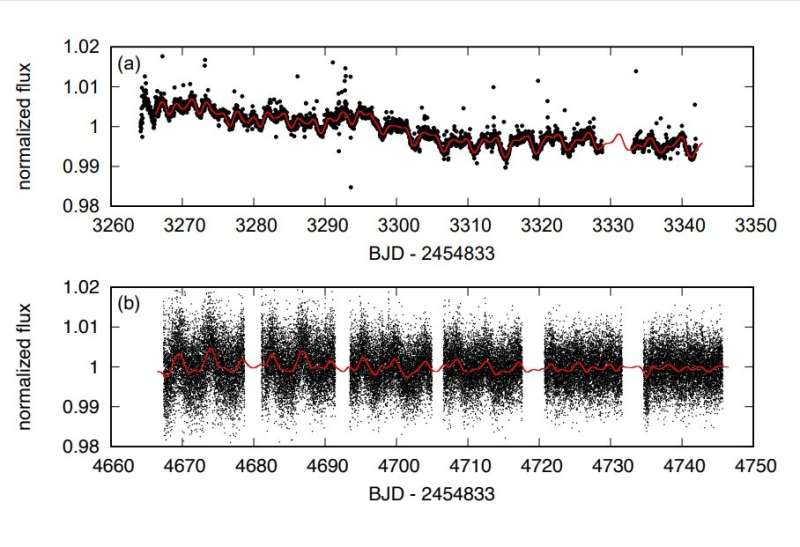Light curves of K2-415 obtained by K2 (top; K2SFF) and TESS (bottom; PDC-SAP). Credit: Hirano et al, 2023
Using NASA's Kepler spacecraft and Transiting Exoplanet Survey Satellite (TESS), astronomers have discovered a new Earth-sized exoplanet located about 70 light years away from the sun. The newfound exoworld, designated K2-415b, is at least three times more massive than the Earth. The finding was reported in a paper published February 1 on the arXiv pre-print server.
Kepler is the most prolific planet-hunting telescope, as it has discovered more than 2,600 exoplanets to date. After the failure of its two reaction wheels in 2013, the mission was repurposed as K2 to perform high-precision photometry of selected fields in the ecliptic. The revived Kepler spacecraft, which operated until November 2018, has detected hundreds of new extrasolar worlds.
When it comes to TESS, the spacecraft is currently conducting a survey of about 200,000 of the brightest stars near the sun with the intent to search for transiting exoplanets. So far, it has identified more than 6,100 candidate exoplanets (TESS Objects of Interest, or TOI), of which about 3,000 have been confirmed so far.
Now, an international team of astronomers led by Teruyuki Hirano of the Graduate University for Advanced Studies (SOKENDAI) in Japan reports that an exoplanet initially identified by the K2 mission in the light curve of M dwarf star K2-415 was confirmed by TESS observations.
"The planet candidate was first identified by analyzing the light curve data by the K2 mission, and is here shown to exist in the most recent data from TESS," the researchers wrote.
The observations found that K2-415b has a radius of approximately 1.015 Earth radii and its mass was calculated to be most likely 3.0 Earth masses. The planet orbits its parent star every 4.018 days at a distance of about 0.027 AU from it. The equilibrium temperature of K2-415b is estimated to be around 400 K.
The host K2-415 is of spectral type M5V and its effective temperature was measured to be 3,173 K. The star has a radius of about 0.2 solar radii and its mass was calculated to be some 0.16 solar masses.
The confirmation of the new exoplanet makes K2-415 the closest planet-hosting star from Earth identified by Kepler/K2 missions. Moreover, K2-415 is now also one of the lowest mass stars hosting an Earth-like planet.
The authors of the paper underlined that K2-415b's proximity to Earth and moderate transit depth make it a potential target for future atmospheric characterization studies of Earth-like planets, especially those having a relatively low temperature.
"The distance of 22 pc and the moderate depth of the transit make K2-415 a good target for future observations, including further RV monitoring (e.g., to search for additional planets) and transit spectroscopy," the researchers concluded.
More information: Teruyuki Hirano et al, An Earth-sized Planet around an M5 Dwarf Star at 22 pc, arXiv (2023). DOI: 10.48550/arxiv.2302.00699
Journal information: arXiv
© 2023 Science X Network
























